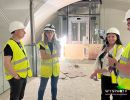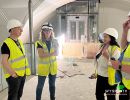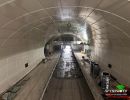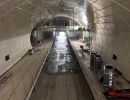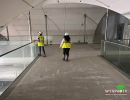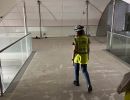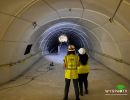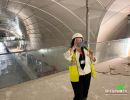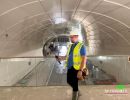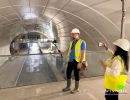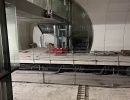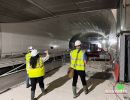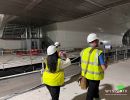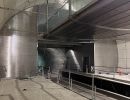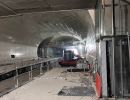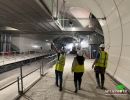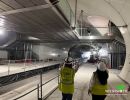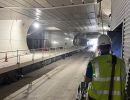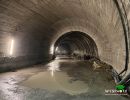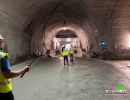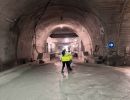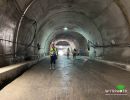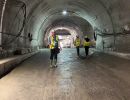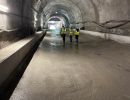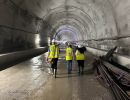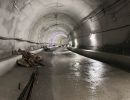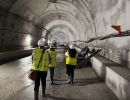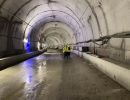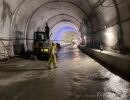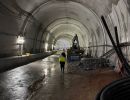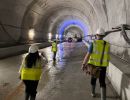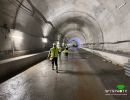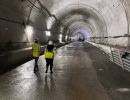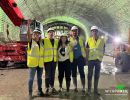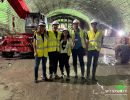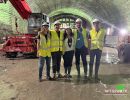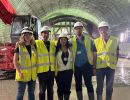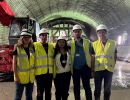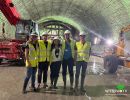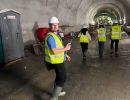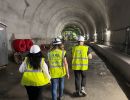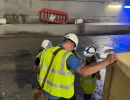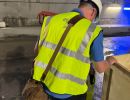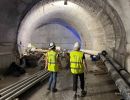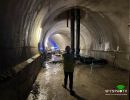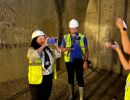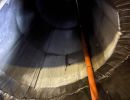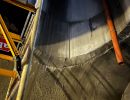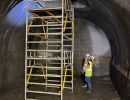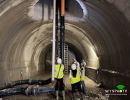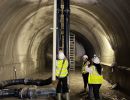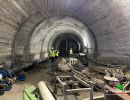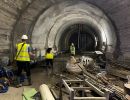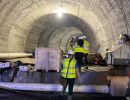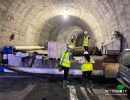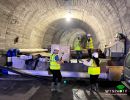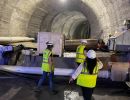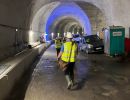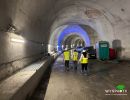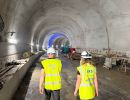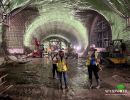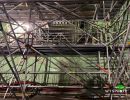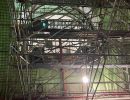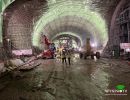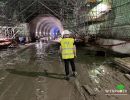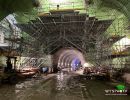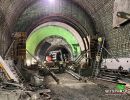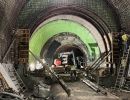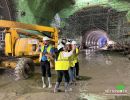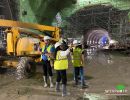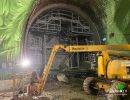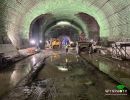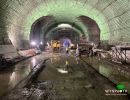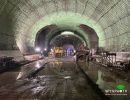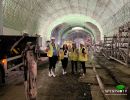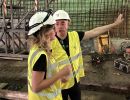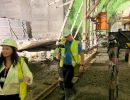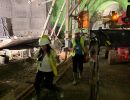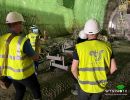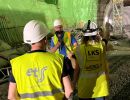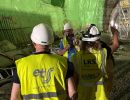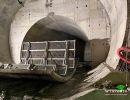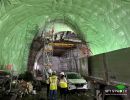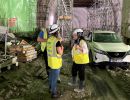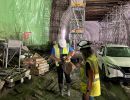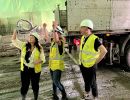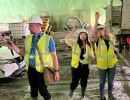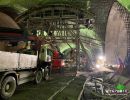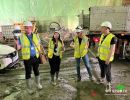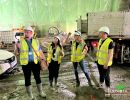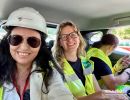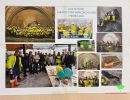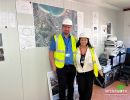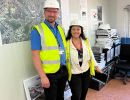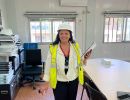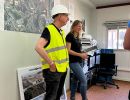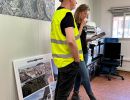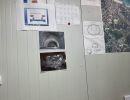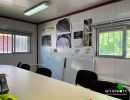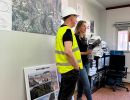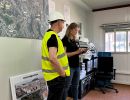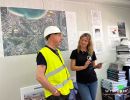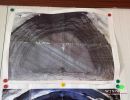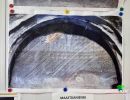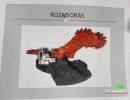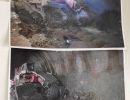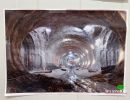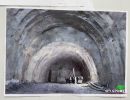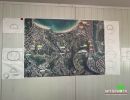Wyspa TV - Where You See People Achieve
SHARE ARTICLE
Select your language
Wyspa TV - Where You See People Achieve
SHARE ARTICLE
We have 2062 guests and no members online
Change language: Polish-PL Spanish-ES
This report serves as a testimony, created as a historical record preserving the image of our present for future generations.
San Sebastián (Donostia) — a city at the meeting point of the ocean and the mountains — is building a new, underground backbone of life. The Wyspa TV team, invited by ETS director Valentín Gómez, was given the opportunity to enter places normally accessible only to technical crews: raw tunnels, utility chambers, shafts, and station mezzanines. At first glance, it seems like “just” the construction of a tunnel. In reality, it is a precisely designed, multi-stage engineering process that combines innovation, safety, and the vision of a sustainable city.
At the core of the project lies a new section of approximately 2.2 kilometres, featuring three stations, which will replace the existing stretch of around 2 kilometres. The surface-level station will be removed, and the land reclaimed from the tracks will be returned to residents as green spaces and housing developments.
Copyright Notice
All rights to the video material, photographs, and the article entitled “Underground Donostia - the metro transforming mobility in the Basque Country”, published on the Wyspa TV website, are reserved and of a historical nature.
Without prior written consent from Golden Rule Ltd / Wyspa TV, it is prohibited to:
• copy, distribute, modify, or use commercially, in whole or in part;
• publish the material on websites, social media platforms, or in printed publications;
• use the photographs and recordings for advertising, promotional, or media purposes.
Only sharing is permitted, with the mandatory inclusion of the source: Wyspa TV (www.wyspa.tv).
Violation of the above restrictions will be treated as an infringement of copyright and will result in legal liability under the laws applicable in the United Kingdom as well as international law.
© Golden Rule Ltd / Wyspa TV
Valentín Gómez explains it in broader terms: the metro is a philosophy of mobility and urban policy. The expected outcome? Fewer cars on the streets, greater freedom of movement, and cleaner air thanks to reduced exhaust emissions. Importantly, the impact will not stop at the boundaries of Donostia: towns along the entire corridor — from Zarautz and Zumai to Irún — will also benefit from a denser and more reliable network of connections.
The heart of this construction beats to the rhythm of mining technology applied in the middle of the city. A roadheader, weighing approximately 140 tons, cuts through the rock; the excavated material is transported away, while the tunnel face advances. Under favourable conditions, progress can reach up to 100 meters per month.
All of this operates 24 hours a day, in three precisely coordinated shifts. A working day on the construction site resembles a well-organised factory: excavation of rock material, hauling it away, and then securing the section.
The greatest challenge for the tunnel is not spectacular mountains, but the everyday reality of urban conditions: the high groundwater level and a layer of sand above the route. This demanded surgical precision: before the first strike of the roadheader, a full survey of all buildings was carried out, with notarial protocols documenting their condition. Measuring points were installed throughout the urban fabric, and even satellite observations were used to monitor micro-movements of structures on the surface.
Not everywhere was the rock “cooperative.” Loose sands required jet grouting — reinforcement of the soil by high-pressure injection. There were also karst sections with unpredictable channels, which likewise required injections to stabilise the ground.
A particular trial occurred in June 2020, when a breach in the lining beneath La Concha beach caused an inflow of water mixed with sand. Drastic technical measures were necessary. On the surface, the Hotel de Londres and two other buildings were evacuated. As Gómez recalls, it was a very difficult and personal time, yet no one was harmed beyond material damage — today the incident is remembered mainly as an anecdote and a lesson learned. Since 2017, no serious accidents have been recorded on the construction site.
We invite you to subscribe if you appreciate our work and want to support us. By clicking the "Subscribe" button and contributing just £2 a month, you help us grow the Wyspa TV channel and gain access to exclusive premium content. Your support means a lot—thank you!
In the urban space, access corridors accompany the stations. In the centre of Donostia, three such entrances will serve the Kontxa (La Concha) station:
near the Hotel de Londres — the “Cañón Suli” with two entrances,
by the cathedral (Loyola axis),
and from San Bartolomé.
These are clear, functional solutions. At one access point, stairs and elevators are planned; a higher level leads passengers onto a mezzanine, from which elevators will take them down to the platforms. At Kontxa, reinforcement work and elevator installation are underway. Above the entire station, a skylight will be added to bring daylight deep into the station.
At the project's peak, approximately 100 people were working on one section and about 60 on another, including support staff; a total of 250–300 people passed through the site. It is a living organism that requires the coordination of shifts, deliveries, storage, and the removal of materials.
In the historic fabric of the city, construction always comes into contact with its surroundings and their constraints. Along the route, a fragment of Donostia’s former walls was found, identified and documented by an archaeologist. As curiosities: an element resembling a Romanesque column capital turned out to be modern; and a cannonball from the Napoleonic Wars, after verification by specialists in munitions and explosives from the Basque police (Ertzaintza), proved to be a solid steel sphere with no charge, a type of projectile used in muzzle-loading cannons. Those were the only “finds” worth mentioning apart from the walls.
From the construction perspective, clarity and the logic of movement are crucial. The route the team covered from the office — about 500 meters in — ran under La Concha beach to a large station, where three entrances are planned (Hotel de Londres, Cathedral/Loyola, San Bartolomé).
Although the section described most strongly changes the local experience of mobility in Gipuzkoa, Gómez sketches a strategic horizon: the “Basque Y,” the high-speed rail network. Once it is connected in the north with France and in the south with the lines to Madrid and Lisbon, within the EU’s Atlantic Corridor, there will be continuity of travel for residents and visitors from across Europe. This is the scale at which Donostia’s metro becomes a node in a larger whole.
“Investments create jobs, wealth and, ultimately, the well-being of society. That is the purpose of public expenditure,” Gómez emphasises. At the same time, he invites Poles to the Basque Country, which boasts a rich culture, language, gastronomy, and landscapes, ranging from beaches to mountains. This is not mere courtesy; it is an invitation to experience a city that consciously invests in quality of life.
Although the structural and functional elements of the metro/rail stations already give the impression of readiness, the installations that ensure legibility and comfort are still missing: lighting, information boards, and wayfinding signage. This is the finishing layer that turns the raw structure into an intuitive travel hub. When daylight appears beneath the skylights, and mezzanines and platforms fill with movement, the city will feel the change not only in the statistics but above all in everyday life.
Thanks to an official invitation from ETS, Wyspa TV not only listened to those responsible for implementation, but also went underground: into the spaces where concrete and steel become tools of a larger narrative about a city that understands its modern future — ecological and integrated with the needs of its residents.
Author/Editor: Maria Anna Furman
